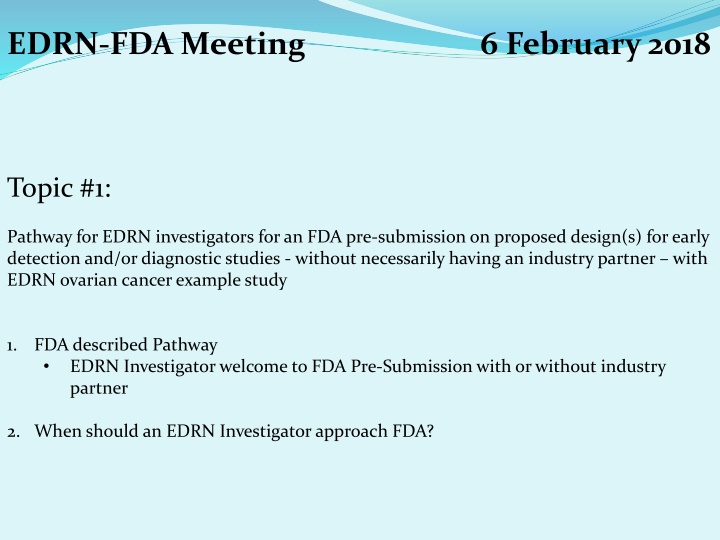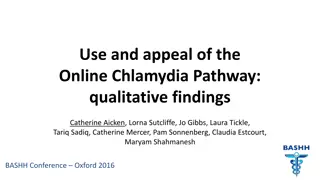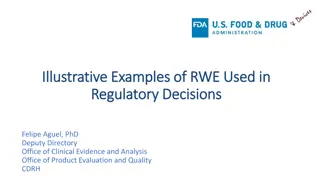Pathway for EDRN Investigators in FDA Pre-Submission for Early Detection Studies
EDRN investigators can approach the FDA for pre-submission without an industry partner for proposed early detection study designs. The process involves validation, verification, and discovery stages in the biomarker pipeline, utilizing various technologies and biospecimen sets. An example from the ovarian validation study showcases the collaboration of EDRN investigators in identifying biomarker candidates for ovarian cancer, highlighting the complexity and depth of the research process.
Download Presentation

Please find below an Image/Link to download the presentation.
The content on the website is provided AS IS for your information and personal use only. It may not be sold, licensed, or shared on other websites without obtaining consent from the author.If you encounter any issues during the download, it is possible that the publisher has removed the file from their server.
You are allowed to download the files provided on this website for personal or commercial use, subject to the condition that they are used lawfully. All files are the property of their respective owners.
The content on the website is provided AS IS for your information and personal use only. It may not be sold, licensed, or shared on other websites without obtaining consent from the author.
E N D
Presentation Transcript
EDRN-FDA Meeting 6 February 2018 Topic #1: Pathway for EDRN investigators for an FDA pre-submission on proposed design(s) for early detection and/or diagnostic studies - without necessarily having an industry partner with EDRN ovarian cancer example study 1. FDA described Pathway EDRN Investigator welcome to FDA Pre-Submission with or without industry partner 2. When should an EDRN Investigator approach FDA?
Biomarker Pipeline Number of candidates Many Discovery Verification Validation Few Filter 2 too late Filter 1 too soon When should EDRN Investigator approach FDA?
Biomarker Pipeline Technology platform Many Discovery Verification Validation Few Filter 2 ELISAs Filter 1 High throughput High accuracy Targeted mass spec Triple Quad Med throughput Med accuracy High resolution Mass Spec OrbiTrap Low throughput Lower accuracy
Biomarker Pipeline Biospecimen Sets Many Discovery Verification Validation Few Filter 2 Filter 1 Easily accessible biofluid (plasma, urine) Preclinical serial samples Easily accessible biofluid (plasma, urine) Unbiased diagnostic cohort Disease or Proximal biospecimen High signal/noise
Biomarker Pipeline Sample Size Many Discovery Verification Validation Few Filter 2 Filter 1 100 s cases 1,000 s controls 50-100 s cases 50-100 s controls 10 s case, 10 s controls 10 4 SD separation 50 2 SD separation
Ovarian Validation Study Early Detection Modified design 150+ ovarian cancer candidates discovered in previous round of funding Diamandis Godwin LaBaer Li Lokshin Marks Skates Accurate Inclusion Mass Screening (Broad) Bioinformatics (in silico) mRNA filter (Toronto) 50 SRM Assays PNNL (BRL) 8 high throughput assays JHU (BRL) + 3 NAPPA (ASU) Cases vs. Benigns at Diagnosis rule out (FHCRC CEVC) Early Detection Biomarkers 11 candidates x Longitudinal samples (MGH/Broad)
Ovarian Validation Study Early Detection Modified design Diamandis Godwin LaBaer Li Lokshin Marks Skates Seven EDRN investigators put forward ovarian cancer biomarker candidates from previous investigations 165 plasma protein candidates contributed Too many to create immunoassays for each candidate Auto-antibody study in parallel at ASU (Anderson) using NAPPA technology (LaBaer) NAPPA nucleic acid programmable protein array nappaproteinarray.org
Ovarian Validation Study Early Detection Modified design Bioinformatics (in silico) mRNA filter (Toronto) Two existing transcriptomic databases reduce candidates based on levels at transcript from 165 to 100 candidates Rank by sensitivity at 98% specificity Level of specificity selected by experience with blood test followed by trans-vaginal sonography for positive blood test 10 fold reduction in false positives Achieves 20% positive predictive value (PPV) 1 in 2,500 1 in 5 ---------- 50 fold blood test x 10 fold TVS
Ovarian Validation Study Early Detection Modified design Accurate Inclusion Mass Screening (Broad) AIMS mass spectrometry technique to measure 100 candidates in two plasma pools Reduce candidates from 100 to 50 Plasma pools from Cases: serous ovarian cancer patients Controls: serous benign ovarian disease
Ovarian Validation Study Early Detection Modified design PNNL Pacific Northwest National Lab (Rodland EDRN BRL) Developed antibody-free, targeted mass-spectrometric approach for quantification of proteins at low picogram /mL levels in human plasma/serum PRISM: high-pressure, high-resolution separations coupled with intelligent selection and multiplexing 50 SRM Assays PNNL (BRL) Developed selective reaction monitoring assays for 50 candidates Where SRM not analytically sensitive enough, developed PRISM assay Evaluated 50 candidates in graduated sample sets: 10 cases vs. 10 controls 20 cases vs. 20 controls
Ovarian Validation Study Early Detection Modified design Johns Hopkins University Dan Chan EDRN BRL Biomarker Reference Laboratory Developed 8 high throughput, low CV, low cost, immunoassays on Mesoscale Diagnostics (MSD) electrochemiluminescence platform 8 high throughput assays JHU (BRL)
4-Plex CA125 HE4 SPON1 FOLR1
Ovarian Validation Study Early Detection Modified design Using parallel process with multiple plasma sample sets at Dx 3 high probability ovarian cancer candidates from over 9,000 antibodies ASU developed 3 antibody candidate assays on MSD platform + 3 NAPPA (ASU)
Ovarian Validation Study Early Detection Modified design Evaluated 11 protein and autoantibody candidates on plasma at Dx from: 100 serous ovarian cancer 100 serous benign ovarian disease Cases vs. Benigns at Diagnosis rule out (FHCRC CEVC)
Ovarian Validation Study Early Detection Modified design Evaluate up to 11 candidates in pre-diagnostic plasma samples from Cases identified during screening study Controls age at study entry and time matched to cases 5 controls per case Blood draw goal was every 3 months averaged 3 times per year 98% specificity per year set by variation within controls over time Sensitivity estimated for 6 mths, 1yr, 2yrs prior to Dx at 98% specificity 11 candidates x Longitudinal samples (MGH/Broad)
Ovarian Validation Study Early Detection Modified design Per Candidate: Systematic evaluation through hierarchical longitudinal mixture model estimates probability of change-point in candidate Panel: hierarchical longitudinal multivariate mixture model estimates probability of change-point in any candidate Evaluate each candidate and panel with sample sets from independent studies If candidate has significant sensitivity prior to Dx at high specificity Early Detection Biomarker Early Detection Classifier.. Early Detection Biomarkers 11 candidates x Longitudinal samples (MGH/Broad)
Known Cancer Biomarkers in Cancer Screening Trials Screening: Measure early detection biomarker at regular intervals Change-point: Rises above each case s baseline before detection Stable over time in controls case Dx CA125 HE4 PSA Pre-diagnostic samples control Time
Ovarian Validation Study Early Detection Modified design 150+ ovarian cancer candidates discovered in previous round of funding Diamandis Godwin LaBaer Li Lokshin Marks Skates Accurate Inclusion Mass Screening (Broad) Bioinformatics (in silico) mRNA filter (Toronto) 50 SRM Assays PNNL (BRL) 8 high throughput assays JHU (BRL) + 3 NAPPA (ASU) Cases vs. Benigns at Diagnosis rule out (FHCRC CEVC) Early Detection Biomarkers 11 candidates x Longitudinal samples (MGH/Broad)























